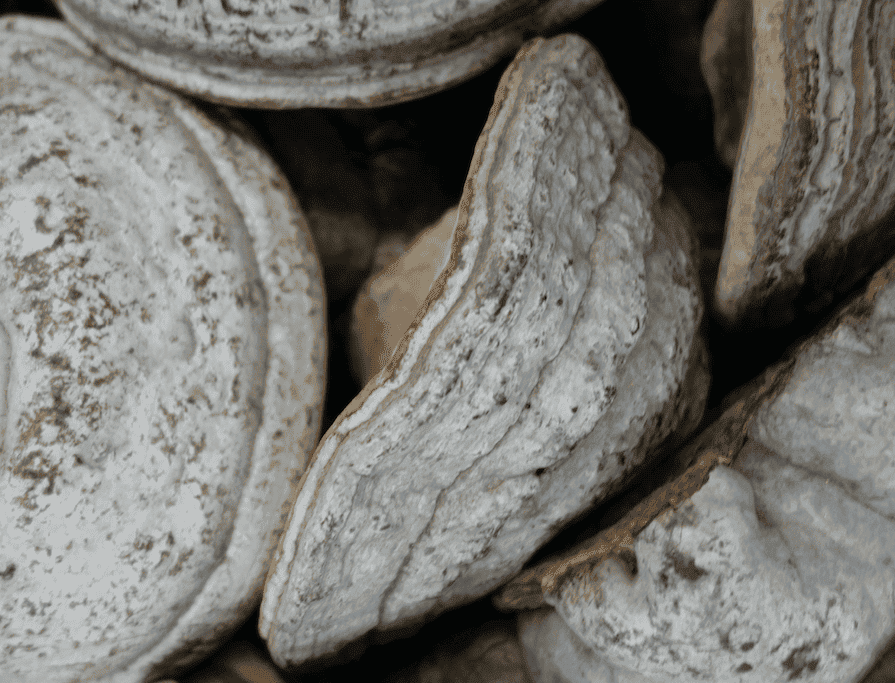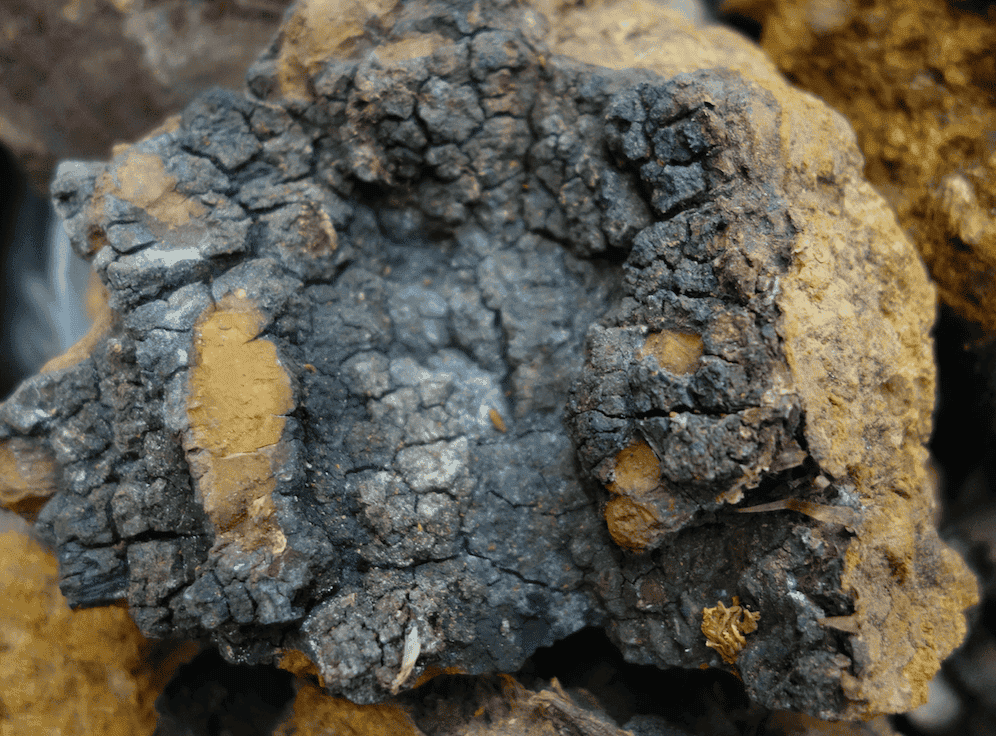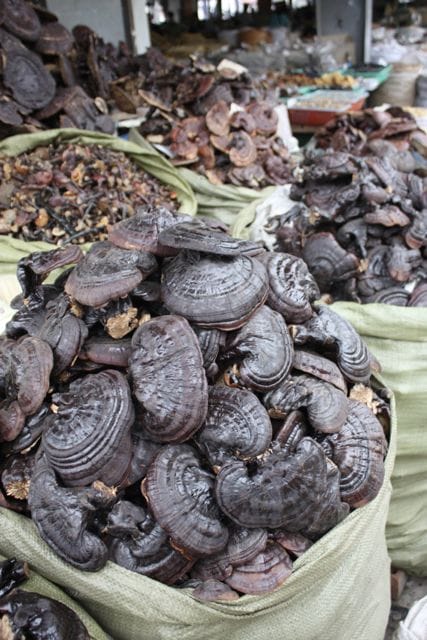

|

|
Medicinal Fungi in Cancer Therapy
By Adam Tate, 2021Medicinal Fungi have been used in all Medical Traditions with their use being traced back well over 2000 years. The most important class of Medicinal Fungi are the Polypores, especially those growing on living or dead wood. The Polypores are a class of Fungi without gills, but rather have tiny holes (poly+pore) on their underside from which their spores are released.
The primary species used in Cancer therapy are well researched. They all contain polysaccharides, particularly beta-glucans, which have been well established to promote immunity and increase immune function in various ways. In addition, various of the species contain other useful chemical compounds.
Some of these have been licensed for use as an adjunct in Cancer therapy in some countries, notably Taiwan, Korea and Japan. However, other countries such as Russia are also known to embrace medicinal mushrooms far more than in the West.
In the past decades, the use of medicinal mushrooms is becoming more popular in the west. With the growing body of evidence showing the marked benefits of these mushrooms, more people are using mushrooms as health supplements, and more companies are incorporating these mushrooms into their products.
|
It’s fair to say this charge has been spear-headed by the Ganoderma Ling Zhi or Reishi, widely used throughout Asia and revered as an ancient medicine of longevity. However, numerous other similar woody bracket-type polypores have showed similar effects to Ling Zhi, some being more potent. And some of these contain other proteins, phenols and other constituents which makes their use in Cancer therapy even more relevant. |
 Bulk Ganoderma Ling Zhi at the Chengdu Market.
Bulk Ganoderma Ling Zhi at the Chengdu Market. |
Despite the fact that there’s little in the way of large-scale placebo-controlled clinical trials, there is ample evidence including extensive research and numbers of case histories which suggest good effects from the use of these Fungii. There are numerous reported cases of advanced cancers with secondaries achieving remission, of statistically better 5-year survival rates being achieved, of chemotherapy and radiotherapy either being more effective or causing fewer side effects due to the concurrent use of medicinal mushrooms.
The problem with Identification
One of the problems with some of the Medicinal Mushrooms is ascertaining correct identification. The classification of various polypores, for example the Ganoderma and Phellinus genus, is confusing even to experts in the field. This is partly evidenced by the large number of synonyms seen for many of these mushrooms. Some mushrooms have been classed as an already known species by some researchers but are classed as a new species by others. This is especially so in mushrooms on different continents. In addition, a quick google image search for any of a number of the medicinal polypores shows great variation, and in some cases, misidentification.
Even Ganoderma lucidum, the famous Ling Zhi or Reishi, is believed by a number of researchers to not be the original species intended in the ancient Chinese and Japanese classics.
Similarities of the Polypores
The good thing is that the large majority of medicinal polypores share some similar chemistry and effects. Outstanding amongst this group, as noted above, is the polysaccharide content. Polysaccharides as a class of compounds are immensely important in traditional medicine, a number of the most important tonic medicines relying heavily on this class of compounds.
The polysaccharides from a number of these medicines show marked beneficial effects on immunity often achieving this with a multi-pronged effect. However, not all polysaccharides share these effects. Starch and cellulose are types of polysaccharides too. It is especially chitin and the beta-glucans which are found in the polypores which are of clinical significance.
The other broad claim we can make about the similar uses of the medicinal polypores is their treatment for what is called ‘Damp’ in TCM. As I have spoken of in other articles, the ‘Damp’ of TCM is akin to the Melancholy of the Western Tradition. Damp and Melancholy in their respective traditions are both associated with chronic, obstinate diseases including Cancer. While it is outside the scope on the current writing to explore the full significance of this, it is suffice to say that both Damp and Melancholy are heavily implicated in Cancer in TCM and Western Traditional Medicine respectively. The White Agaric of the West (Fomitopsis officinalis) has long been used to clear Phlegm, Damp and Melancholy and is used in a number of Traditional formula used for Cancer. Likewise commonly used Chinese fungii such as Poria Fu Ling are regularly used in Cancer therapy. But across the varied species of polypore used, it can be seen that clearing Damp is a common indication.
Those who have studied TCM will understand the close link between Damp, the Spleen, Energy and Immunity. In modern research, Spleen Qi tonics (Ginseng, Astragalus, Atractylodes, Licorice etc) are almost universally seen to enhance immunity. Therefore, the fact that these medicines as a class typically clear Damp while stimulating immunity makes them an important class of medicines with tonic-like properties.
It is perhaps also worth noting that these mushrooms also tend to contain good levels of trace minerals, but for the same reason, are apt to contain heavy metals in areas with contamination. Trace minerals have been noted as being low due to modern farming methods, and other research has shown links between trace minerals and deifiency in TCM diagnosis. For example, Zinc deficiency is commonly seen in those with Kidney deficiency. So these slow-growing, wood-rot fungi like Ganoderma, Fomitopsis and Phellinus will accumulate useful trace minerals which can enhance the therapeutic effect in chronic diseases of deficiency.
Differences in the Polypores
Many of the polypores also have unique qualities. The White Agaric of the West (Fomitopsis officinalis) contains a bitter; a number have unique phenols, and the Birch Mushrooms tend to contains Betulin, derived from the bark of the Birch tree.
Importantly, the Polysaccharides are not all the same. Despite being closely related and tending to have similar effects on immune function, the polysaccharides differ in composition, strength of effect, and bioavailability. Their non-polysaccharide compounds also help to target their effects.
Wide Ranging Effects
We have well established the immune-improving effects of the polypores. But there are a number of other uses for the various species. As Ganoderma lucidum (Ling Zhi or Reishi) is so well researched, the indications for this is particularly wide.
Some have shown anti-bacterial or anti-viral effects; some have positive effects on cardiovascular health or diseases of old age such as cognitive decline; a number have hypoglycaemic effects; some are useful in neurasthenia and insomnia, and are regarded as ‘calming the Spirit’. For more on this, have a look at our Primary Uses of Medicinal Fungi
A common thread throughout most of their uses is a tonic principle; that is, a strengthening, restoring or tonifying effect.
This means they have special use in:
1. Chronic disorders of deficiency
2. Disorders of old age
3. Tumor and Cancer therapy
The use in Cancer therapy
All traditions have used medicinal mushrooms to a greater or lesser extent. Particularly the Asian systems in China, Korea and Japan, medicinal mushrooms are a major industry, and there is a strong overlap between medicinal and culinary mushrooms, many being considered health foods. The use of White Agaric (Fomitopsis officinalis) in the West was especially prominent in Cancer therapy after the Arab and Persian influence around 1000 years ago. However, as a medicine highly regarded to treat Melancholy diseases, and Cancer being classed as a Melancholy disease, it has been used in the treatment of Fibroid Tumors and Cancers for over 2000 years.
In recent decades a number of important mushrooms have been well researched for use in specific types of Cancers, and some of these have been licensed in the above-mentioned Asian countries for use in Cancer therapy, usually in conjunction with chemotherapy and radiotherapy.
Some Fungi are widely used in herbal formulas in TCM, Poria Fu Ling being the most common. However, it appears most typically that many of these mushrooms have been used alone, usually as decoction, but sometimes as a powder.
Now, concentrated extracts or polysaccharide-rich extracts are marketed and used in Cancer therapy in places like Korea and Japan. But there are specialists who widely use a range of medicinal fungi and Cancer is disease which is treated with some Mushroom-based formula.
Sample Polysaccharide-rich Fungi-based Cancer-supporting Formula
A typical formula which can be used widely in Cancer therapy either during conventional treatment, between cycles, in the passive treatment of terminal stages and in patients who otherwise refuse standard treatment, as well as during remission, is as follows:
Ganoderma lucidum (Ling Zhi, Reishi) 10 grams
Poria Fu Ling 10 grams
Trametes (Turkey Tail, Yun Zhi) 10 grams
Phellinus linteus Sang Huang 10 grams
Astragalus Huang Qi 30 grams
This is decocted once daily and taken in 2 or 3 equal doses over the day. Usually, one course of treatment is 3 months.
Of course, this can be added to or modified as needed. Black Nightshade, Extracts of Hedyotis Bai Hua She She Can, Scutellaria Ban Zhi Lian or Rabdosia are common TCM anti-cancer additions to various formulas based on their well established anti-cancer effect. If the patient is undergoing Chemo- or radio-therapy, then often our best bet is to focus on supporting the body, increasing energy and enhancing immunity, which the above formula will achieve.
Experimental Cancer Formulas using Medicinal Fungi
As noted above, these can be used with Chemo- or radio-therapy, or in cases where conventional treatment isn’t tolerated or the patient has decided not to take conventional medicine.
These types of formulas in general have been shown to increase immunity, have direct anti-cancer function, often appear to lessen side-effects of chemotherapy, and in some cases, have been shown to enhance toxicity of chemotherapy to cancer cells, showing a useful synergistic effect.
The following formulas are based on formulas of Professor Zhang Wen Peng of the China Academy of Chinese Medical Sciences. A number of his mushroom-based Cancer formulas have been widely reported since 2019 in Chinese media. Some of the following formulas have been slightly simplified but have been translated to show composition, combination and doses when using various medicinal mushrooms together.
The formulas have been obviously deliberately written to only include Medicinal Mushrooms. They are stated to be basic starting points which should be added to or modified as required but have been designed for each particular Cancer based on research or experience showing positive results in that particular cancer.
In the following formulas, a course of treatment is 3 months, with 1–3 courses being recommended to be taken. Each prescription is designed for decoction to be taken over the course of one day.
Lung Cancer
Liver Cancer
|
Cervical Cancer
|
Conclusion
One of the take-home facts after reading this article is to remember that in natural and traditional medicine, some of our greatest weapons in various chronic diseases and diseases of old age are the various polysaccharides which are notable constituents in basically all of the medicinal mushrooms. And therefore, these types of multi-drug formulas composed of mushrooms are partly just a complex of various mushroom polysaccharides, along with other useful admixtures including phenols, steroids and trace minerals.
-
Appendices
- Fungi for Specific Cancers
-
Primary Chinese Medicinal Fungi
Appendic 1: Primary Medicinal Fungi for Specific Cancers
|
BLADDER Grifolia frondosa Phellinus linteus Polyporus umbellatus Zhu Ling Poria cocos Fu Ling BRAIN Inonotus obliquus, Chaga Grifolia frondosa BREAST PSK (Polysaccharide K) Ganoderma applanatum Ganoderma lucidum Ling Zhi (Estrogen dependent) Grifolia frondosa Inonotus obliquus, Chaga Lentinula edodes (Shiitake) Phellinus linteus (Estrogen dependent) Polyporus umbellatus Zhu Ling Poria cocos Fu Ling Trametes versicolor (Turkey Tail) CERVICAL Agaricus subrufescens (incl. Endometrial) Ganoderma applanatum Schizophyllum commune (licensed for use in Japan for Cervical Cancer with good results in Stage II but not stage III) Trametes versicolor (Turkey Tail) Flammulina velutipes Phellinus linteus, Sang Huang COLORECTAL PSK (Polysaccharide K) Agaricus sylvaticus Ganoderma applanatum Ganoderma lucidum Ling Zhi Inonotus obliquus, Chaga Lentinula edodes (Shiitake) Trametes versicolor (Turkey Tail) ESOPHAGEAL Trametes versicolor (Turkey Tail) GASTRIC / STOMACH PSK (Polysaccharide K) Ganoderma applanatum Lentinula edodes (Shiitake) Phellinus linteus, Sang Huang Trametes versicolor (Turkey Tail) LEUKEMIA PSK (Polysaccharide K) Agaricus subrufescens Cordyceps Ganoderma lucidum Ling Zhi Grifolia frondosa Phellinus igniarius Poria cocos Fu Ling Trametes versicolor (Turkey Tail) |
LIVER CANCER Agaricus subrufescens Flammulina velutipes Ganoderma lucidum Ling Zhi Grifola frondosa Inonotus obliquus, Chaga Lentinula edodes (Shiitake) Phellinus Linteus Pleurotus ostreatus Polyporus Zhu Ling LUNG CANCER PSK (Polysaccharide K)–marked benefit Agaricus subrufescens Grifolia frondosa Inonotus obliquus, Chaga Laricifomes officinalis (Agarikon) Phellinus igniarius Phellinus linteus Poria Fu Ling Trametes versicolor (Turkey Tail)–strong effect LYMPHOMA Ganoderma lucidum Ling Zhi Trametes versicolor (Turkey Tail) MELANOMA Inonotus obliquus, Chaga Lentinula edodes (Shiitake) Trametes versicolor (Turkey Tail) MYELOMA Agaricus blazei (82%) +Hericium erinaceus (14.7%) + Grifola frondosa (2.9%) OVARIAN PSK (Polysaccharide K) Agaricus subrufescens Poria cocos Fu Ling PANCREATIC PSK (Polysaccharide K) Ganoderma Ling Zhi Omphalotus olearius (cytotoxic component from) Poria Fu Ling PROSTATE Agaricus bisporus Agaricus subrufescens Flammulina velutipes (Androgen dependent) Ganoderma Ling Zhi Inonotus obliquus, Chaga Lentinula edodes (Shiitake) Phellinus linteus Phellinus igniarius Pleurotus ostreatus (Androgen dependent) Trametes versicolor (Turkey Tail) |
Bai Bian Ceng Kong Jun 白邊層孔菌 Ganoderma albomarginatum or Inonotus niveomarginatus
Bao Pi Xian Kong Jun 薄皮纖孔菌 Inonotus cuticularis
Cheng Huang E Gao Jun 橙黃鵝膏菌 Amanita citrina
Cu Mao Huang He Kong Jun 粗毛黃褐孔菌 Xanthochrous hispidus
Dong Fang Shuan Kong Jun 東方栓孔菌 Trametes orientalis
Hong Yuan Ceng Kong Jun 紅緣擬層孔菌 Fomitopsis pinicola
Hua Zhe Kong Jun 樺褶孔菌. Lenzites betulina
Hui Shu Hua 灰樹花 Grifola frondosa
Huo Mu Ceng KongJjun 火木層孔菌. Phellinus igniarius
Jia Zhi 假芝 Amauroderma rugosum
Jing Ding Ce Er 金頂側耳 Pleurotus citrinopileatus (Golden Oyster Mushroom)
Ku Bai Ti 苦白蹄 Fomitopsis officinalis (White Agaric)
Lie Ti Mu Ceng Kong Jun 裂蹄木層孔菌 Phellinus linteus
Lie Zhe Jun 裂褶菌 Schizophyllum commune
Ling Zhi 赤芝 Ganoderma lucidum
Liu Huang Jun 硫黃菌 Beggiatoa alba
Lu Shuan Kong Jun 綠栓孔菌 Trametes gibbosa
Mao Feng Wo Jun 毛蜂窩菌 Hexagonia apiaria (Honeycomb fungus)
Mu Ti Ceng Kong Jun 木蹄層孔菌 Fomes fomentarius
Mu Ti Ling Zhi 木蹄灵芝 Ganoderma formosissimum
Sang Huang 桑黃 Phellinus linteus / P. igniarius
Shu She Ling Zhi 樹舌靈芝 Ganoderma applanatum
Song Zhen Ceng Kong Jun 松針層孔菌 Phellinus pini.
Yu Sheng Ni Ceng Kong Jun 榆生擬層孔菌 Fomitopsis ulmaria
Yun Zhi 雲芝 Trametes versicolor (Coriolus versicolor)
Zhuo Gai Jia Zi 皺蓋假芝 Amauroderma rude
Zhou Gai Yun Zhi 皺蓋雲芝 Trametes spp. (Wrinkled Turkey Tail)
Zi Ding Xiang Mu 紫丁香蘑 Clitocybe nuda (Lepista nuda)
Zhu Zhuang Tian Tou Gu 柱狀田頭菇 Agrocybe cylindracea (Cyclocybe aegerita)
Zhu Huang, Zhu Xuang 竹黃 Shiraia bambusicola (Bamboo mushroom)
Zhu Ling 猪苓 Polyporus umbellatus
See also
Fungal Materia Medica
Primary Uses of Medicinal Fungi
Anti-Cancer Materia Medica
References and Further Reading
Professor Zhang Wen Peng of the China Academy of Chinese Medical Sciences
–Medicinal Mushrooms in the Treatment of Cancer (药用真菌治肿瘤) Edited by Zhang Wenpeng and Chen Kanglin
–https://kknews.cc/health/8v4e284.html
National Library of Medicine Database (PubMed)
Medicinal Mushrooms, A Clinical Guide, Martin Powel, 2014
Medicinal Mushrooms: Their therapeutic properties and current medical usage with special emphasis on cancer treatments, Smith, Rowan and Sullivan, May 2002
Evidence-based Anticancer Materia Medica, W. Cho, 2011 (Springer)
